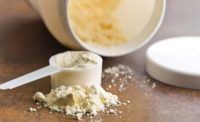In September, researchers, manufacturers and end users of whey protein from around the world gathered in Chicago for the eighth International Whey Conference. A key takeaway from the conference is that whey protein continues to be the “gold standard” for fueling muscle protein synthesis (MPS).
However, whey protein will face significant competition in coming years from plant proteins. Some food and beverage manufacturers will choose to combine whey with plant proteins or other nutrients to create fortified foods for special populations. Three speakers from the conference shared the latest updates on optimizing nutrition, taste and functionality in protein-fortified foods.
Whey, leucine blends show promise
The optimal dosage of protein to maximize MPS and retention will depend on both age and body weight. Research has shown that 0.25-gram/kilogram body mass of high-quality protein (equivalent to approximately 20 grams for a 70-kilogram male) is necessary for maximal stimulation of MPS in young adults. Whey protein contains the highest level of leucine of any protein, and research has shown that leucine is a trigger for MPS. Blending whey with leucine might create unique fortified foods for special populations.
“A 20-gram serving of whey protein contains approximately 3 grams of leucine and is sufficient to robustly stimulate/trigger translation initiation and MPS in most healthy adults,” said Doug Paddon-Jones, Ph.D., professor of aging and health, University of Texas Medical Branch, Galveston, Texas. “Consuming a smaller — e.g., 10-gram — serving of whey fortified with additional leucine may provide some anabolic advantage … but the effect is rapidly saturable.
“Individuals whose ability to consume regular quantities of food/supplements is compromised may benefit from leucine-fortified whey protein,” he added. “This could include populations with strict energy requirements — e.g., bariatric surgery patients — or pronounced issues with satiety, nausea, etc.”
Whey, plant protein blends warrant more study
Many successful products combine dairy protein with plant proteins to provide a functional or cost-savings benefit. However, there is scant information about the nutritional equivalency of these blends, according to Oliver C. Witard, Ph.D., senior lecturer, physiology, exercise and nutrition research, University of Stirling, Scotland.
“The protein blend administered in published scientific studies consists of 75% dairy protein and 25% soy protein,” he noted. “Hence, the contribution of the lower-quality protein source — i.e., soy) — to the protein blend is minimal. While these studies report a similar muscle anabolic response between whey and protein blend conditions, these findings are likely due to the large contribution of dairy protein to the protein blend.
“Future work is required to compare a protein blend consisting of a larger proportion … of lower-quality protein to the protein blend,” he added. “To date, no study has characterized the optimal dose of a protein blend to maximize the stimulation of MPS at rest or following exercise.”
Other non-protein nutrients may enhance MPS, particularly with older adults who have a blunted response to dietary protein.
“There is evidence in older adults that combining omega-3 polyunsaturated fatty acids with protein augments the stimulation of MPS. However, we have not been able to replicate this finding in young adults, at least when an optimal dose of protein is consumed,” Witard noted.
Ingredient functionality
To succeed, protein-fortified foods, whether developed using a single protein source or a blend, must have consumer appeal. Advances in whey manufacturing have created whey ingredients with mild flavor profiles that can be incorporated into products with an extended shelf life.
“Overall, you want whey protein ingredients that undergo minimal changes over time. Modifications that prevent cross-linking between proteins or swelling of protein particles should help minimize bar hardening,” said Allen Foegeding, Ph.D., Department of Food, Bioprocessing and Nutrition Sciences, North Carolina State University, Raleigh, N.C. “In beverages, the key is to minimize
changes caused by the thermal process. Undesirable changes include generation of off flavors and extensive aggregation of proteins. Any modification that would slow aggregation, or direct aggregation to stop at a small particle size, should be beneficial.”
Savvy attendees at the conference also explored emerging markets, applications and technologies for protein fortification. Innovative processing of whey ingredients, coupled with increasingly precise methods of measuring their nutritional benefit, should allow dairy proteins to securely compete with and complement plant proteins well into the next decade.







